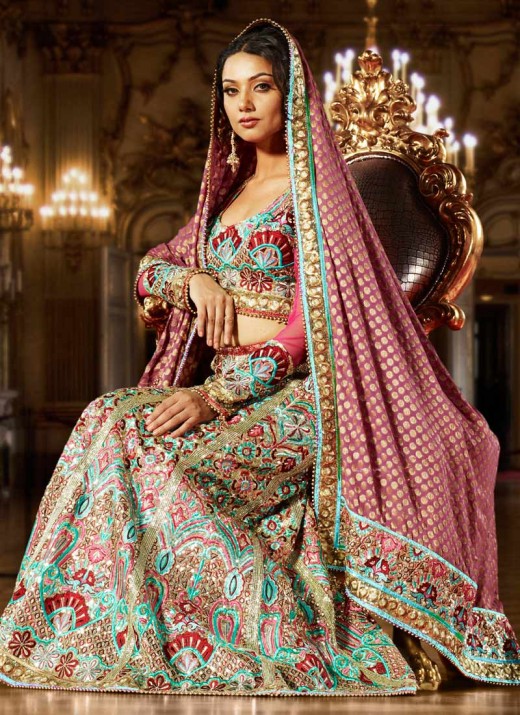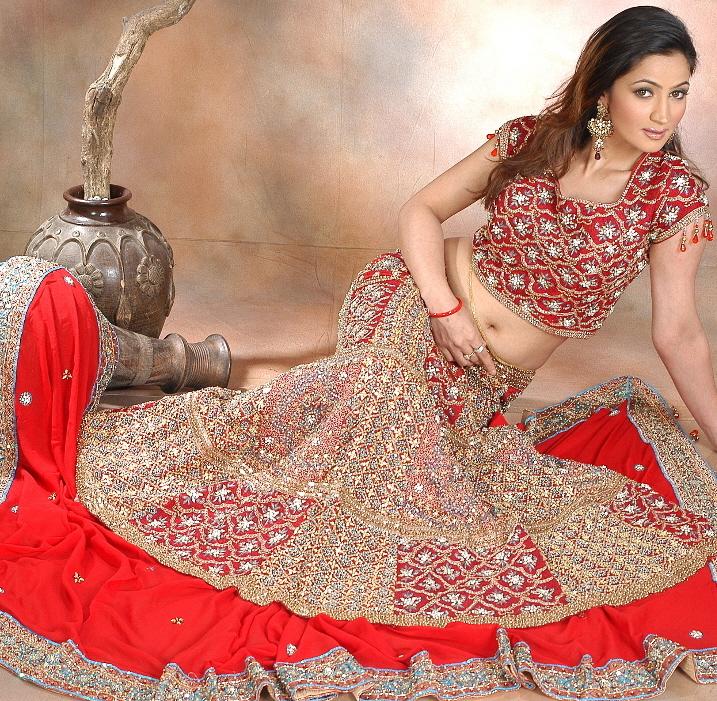Wedding Ghagra Choli Definition
Source(Google.com.pk)
A choli (Hindi: चोली, Gujarati: ચોળી, Marathi: चोळी, ravike in South India, Tamil: ரவிகே, Telugu: రవికె, Kannada: ರವಿಕೆ) is a midriff-baring blouse shell garment in the Indian sari costume worn in India, southern Nepal, Pakistan, Sri Lanka, Bangladesh, and other countries where the sari is worn.[1] It is also part of the ghagra choli costume of India. The choli is cut to fit tightly to the body and has short sleeves and a low neck. The choli is usually cropped, allowing exposure of the midriff and the navel; the cropped design is particularly well-suited for wear in the sultry South Asian summers.[2]
Contents [hide]
1 Evolution
1.1 Indian paintings
1.2 Historic photographs
2 Changing times
3 Fabrics
4 Colours
5 See also
6 References
Evolution[edit]
Choli from Gujarat at the Peabody Essex Museum
The term "choli" is derived from another ruling clan from south, the Cholas.[3] Rajatarangini (meaning the 'river of kings'), a tenth century literary work by Kalhana, states that the Choli from the Deccan was introduced under the royal order in Kashmir.[3] The first cholis were front covering, with choli tied at the back with four strings. Choli of this type are still common in state of Rajasthan.[4] Pre-Christian era paintings of Maharashtra and Gujarat are considered the first recorded examples of choli. Poetic references from works like Silapadikkaram indicate that during the Sangam period 3rd century BC - 4th century CE in ancient South India, a single piece of clothing served as both lower garment and upper shawl. In Kerala, paintings by Raja Ravi Varma indicate women being topless. On the contrary,other historians point to much textual and artistic evidence for various forms of breastband and upper-body-shawl.[2]
Indian paintings[edit]
Women in Choli and Antariya CE 320 Gupta Empire.
Women in Choli CE 320 Gupta Empire. Early form of Choli tied at the back with front covering.
Dancing girl in Kurta/Salwar-like Choli Gupta Empire.
Kalpasutra Manuscript c.1375-1400. Example of early form of full sleeve choli.
Detail of Vasant Ragini, Rajastani painting 1500s - Showing early form of choli tied at the back.
Bhagavata Purana manuscript ca.1525-40
Bhairavi Ragini, Manley Ragamala manuscript ca.1610.
Female musicians at Aurangzeb's wedding - Mughal ca.1636.
Krishna flirting with the Gopis, to Radhas sorrow - Kangra Painting ca.1760. Full sleeve choli and bodics worn in Himalayan states of India.
Women in early form of Mundum Neriyathum. A style of clothing worn by women in Kerala without choli.
Historic photographs[edit]
Tamil girl in choli
Tamil women in choli
Bengali girl in full sleeve choli (1880)
Sri Lankan woman in choli (1880)
Marathi woman in choli
Changing times[edit]
Bollywood actress Yuvika Chaudhary in a modern sleeveless choli that resembles a sports bra.
During the 1960s, a woman was not considered quite a 'lady' if she bared her neckline far too daringly and shoved the sari pallu on to one side, only to give a glimpse of her bosom. A lady of honour ideally covered her back and upper arms, and her blouse was made of a thick fabric. Of course, every woman followed the norm. In the 1970s and 1980s, the blouses went knotty, criss-crossed with a deep cut and shone through the sheer saree.[5] Anupama Raj, a boutique owner commented, "There is a very real need to re-invent the choli so that it can be worn with a variety of outfits. Just as we see the choli to be a deconstructed form of the blouse, we need to deconstruct the choli. Only then, will it be acceptable internationally." Bobby Malik, an exporter-turned-designer commented,"The choli is the most sensuous of all garments created for women. It not only flatters the feminine form, but also brings out the romanticism in a woman. But where Indian designers have failed is at giving it an international look and making it still more beautiful."[6]
Today the entire approach towards the choli is adventurous.The metamorphosis of cholis from being demure and sedate in the past decades to daring in terms of adventurous tailoring with innovative necklines such as halter, tubes, backless or stringed, is worth a mention.[7] Designer Manish Malhotra said, "Since most young people follow a healthy gym routine and are at ease with their bodies, they want to look different and still be effortlessly comfortable. They like to travel and carry a sense of Indianness around them."[5] Designer Vikram Phadnis said, "It's also to do with the fact that the new age woman is well-travelled, well-read and open to experimentation."[8] Sonora Kabir, another Delhi-based designer commented, "Normally, the choli is supposed to hover around the navel area. But if you crop the lower edges and combine it with a funky design — beads, embroidery etc.,— it would be chic enough to be worn over jeans or a pair of trousers."[6]
Fabrics[edit]
Actress Eesha Koppikhar in an embroidered choli.
Traditionally, the choli has been made from the same fabric as the sari, with many sari producers adding extra length to their products so that women can cut the end of the sari off and sew it into a matching choli. Cholis are made out of many fabrics.[1] For everyday wear, cotton-based materials such as terry-cot and silk cotton are comfortable. Chiffon, silk, crepe and satin fabrics are best suited for occasions.[8] The ideal fabric for cholis in summer is chiffon and georgette.[9] Sheer and other transparent fabrics are considered to add glamour provided they come with a lining in the right places. But cholis made out of velvet and suede are considered the deadliest faux pas for the Indian culture.[8]
Colours[edit]
The colour of the choli is usually matched with the colour of the sari. Currently, the cholis are worn in contrast colours to that of the colour of the sari.[1][10] Colours like black, white, navy blue, deep purple, crimson red, lemony yellow, hot pink and sea green are mostly preferred.[8] The colour of the moment is shades of blue and aqua.Designers also recommend that the skin tone should be taken into consideration before choosing what colour the blouse should be. Fairer skins are at an advantage as they can carry any colour. Darker hues such as navy and black can make one appear slimmer. Fluorescent colours are mostly avoided.[11]
Other than the colour, prints are also given significance. Embroidery on blouses that use threads of contrasting shades is considered trendy.[12] For formal occasions, embroidered blouses are still very popular.[11] When wearing a crepe sari, richly embroidered, sheer cholis are preferred.[13] Other embellishments that could make an appearance on your blouse include sequins, kundan work and crystals.[8]
Wedding Ghagra Choli Image Photo Pictures 2013

Wedding Ghagra Choli Image Photo Pictures 2013

Wedding Ghagra Choli Image Photo Pictures 2013

Wedding Ghagra Choli Image Photo Pictures 2013

Wedding Ghagra Choli Image Photo Pictures 2013

Wedding Ghagra Choli Image Photo Pictures 2013

Wedding Ghagra Choli Image Photo Pictures 2013

Wedding Ghagra Choli Image Photo Pictures 2013
Wedding Ghagra Choli Image Photo Pictures 2013
Wedding Ghagra Choli Image Photo Pictures 2013

Wedding Ghagra Choli Image Photo Pictures 2013

Wedding Ghagra Choli Image Photo Pictures 2013

Wedding Ghagra Choli Image Photo Pictures 2013
Wedding Ghagra Choli Image Photo Pictures 2013

No comments:
Post a Comment